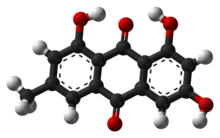Emodin

| |

| |
| Names | |
|---|---|
| IUPAC name
1,3,8-trihydroxy-6-methylanthracene-9,10-dione [clarification needed]
| |
| Other names
6-methyl-1,3,8-trihydroxyanthraquinone
| |
| Identifiers | |
3D model (JSmol)
|
|
| ChEBI | |
| ChEMBL | |
| ChemSpider | |
| DrugBank | |
| ECHA InfoCard | 100.007.509 |
| KEGG | |
PubChem CID
|
|
| UNII | |
CompTox Dashboard (EPA)
|
|
| |
| |
| Properties | |
| C15H10O5 | |
| Molar mass | 270.240 g·mol−1 |
| Appearance | orange solid[1] |
| Density | 1.583±0.06 g/cm3 |
| Melting point | 256 to 257 °C (493 to 495 °F; 529 to 530 K) |
| Boiling point | 586.9 ± 39.0 °C[2] |
Except where otherwise noted, data are given for materials in their standard state (at 25 °C [77 °F], 100 kPa).
| |
Emodin (from Rheum emodi, a Himalayan rhubarb) is a purgative resin, 6-methyl-1,3,8-trihydroxyanthraquinone, from rhubarb, buckthorn and Japanese knotweed (Fallopia japonica syn. Polygonum cuspidatum).[3] It is also produced by many species of fungi, including members of the genera Aspergillus, Pyrenochaeta, and Pestalotiopsis, inter alia. Synonyms for emodin include emodol, frangula emodin, rheum emodin, 3-methyl-1,6,8-trihydroxyanthraquinone, Schuttgelb, and Persian Berry Lake.[4]
Pharmacology
This section needs more reliable medical references for verification or relies too heavily on primary sources. (March 2015) |  |
Emodin is being studied as a potential agent that could reduce the impact of type 2 diabetes. It is a potent selective inhibitor of the enzyme 11β-HSD1.[5] In studies in obese mice, emodin limits the effect of glucocorticoids and may therefore ameliorate diabetes and insulin resistance.[6]
Pharmacological studies have demonstrated that emodin when isolated from rhubarb exhibits anti-cancer effects on several human cancers, including human pancreatic cancer.[7][8][9] Emodin in rhubarb extracts may also have neuroprotective properties against glutamate toxicity.[10]
Aloe-emodin (1,3,8-trihydroxyanthraquinone) is a variety of emodin found in Socotrine, Barbados, and Zanzibar aloes, but not in Natal aloes.[citation needed]
Emodin is also shown to block cytomegalovirus infections as well as herpes simplex. Research is currently being performed in this area.
List of species that produce emodin
- Senna obtusifolia[11] (syn. Cassia obtusifolia[12])
- Fallopia japonica[13] (syn. Polygonum cuspidatum[14])
- Ventilago madraspatana[15]
- Kalimeris indica[16]
- Rumex nepalensis[17]
- Polygonum hypoleucum[18]
- Cassia occidentalis[19]
- Cassia siamea[20]
- Acalypha australis[21]
- Rheum palmatum[22]
- Thielavia subthermophila[23]
- Glossostemon bruguieri [24]
- Rhamnus cathartica common buckthorn[25]
- Rhamnus alnifolia alderleaf buckthorn[25]
Compendial status
References
- ^ Herbal Extract Online. http://herbalextractonline.com/Herbal-Extract/Emodin.html (accessed 9 November 2014).
- ^ Scifinder (accessed 9 November 2014). Emodin (518-82-1) Experimental Properties.
- ^ Dorland's Medical Dictionary (1938)
- ^ PubChem. http://pubchem.ncbi.nlm.nih.gov/compound/emodin (accessed Sept 17, 2014)
- ^ Feng, Y.; Huang, S. L.; Dou, W.; Zhang, S.; Chen, J. H.; Shen, Y.; Shen, J. H.; Leng, Y. (2010). "Emodin, a Natural Product, Selectively Inhibits 11β-Hydroxysteroid Dehydrogenase Type 1 and Ameliorates Metabolic Disorder in Diet-Induced Obese Mice". British Journal of Pharmacology. 161 (1): 113–126. doi:10.1111/j.1476-5381.2010.00826.x. PMC 2962821. PMID 20718744.
- ^ Novel diabetes hope comes from Chinese herbs, esciencenews.com, 17 August 2010
- ^ Lin, S.; Chen, H.; Wei, W.; Ye, S.; Liao, W.; Gong, J.; Jiang, Z.; Wang, L.; Lin, S. (2011). "Antiproliferative and Antimetastatic Effects of Emodin on Human Pancreatic Cancer". Oncology Reports. 26 (1): 81–89. doi:10.3892/or.2011.1257. PMID 21491088.
- ^ Sun, Y. (2008). "Chemosensitization by Emodin, a Plant-Derived Anti-Cancer Agent: Mechanism of Action". Cancer Biology & Therapy. 7 (3): 476–478. doi:10.4161/cbt.7.3.5584. PMID 18245955.
- ^ Dorsey, J. F.; Kao, G. D. (2007). "Aloe(-Emodin) for Cancer? More than Just a Comforting Salve" (pdf). Cancer Biology & Therapy. 6 (1): 89–90. doi:10.4161/cbt.6.1.3845. PMID 17297301.
- ^ Gu, J. W.; Hasuo, H.; Takeya, M.; Akasu, T. (2005). "Effects of Emodin on Synaptic Transmission in Rat Hippocampal CA1 Pyramidal Neurons in vitro". Neuropharmacology. 49 (1): 103–111. doi:10.1016/j.neuropharm.2005.02.003. PMID 15992585.
- ^ Dr. Duke's Phytochemical and Ethnobotanical Databases
- ^ Yang, Y.-C.; Lim, M.-Y.; Lee, H.-S. (2003). "Emodin Isolated from Cassia obtusifolia (Leguminosae) Seed Shows Larvicidal Activity against Three Mosquito Species". Journal of Agricultural and Food Chemistry. 51 (26): 7629–7631. doi:10.1021/jf034727t. PMID 14664519.
- ^ http://www.ars-grin.gov/cgi-bin/duke/highchem.pl [dead link]
- ^ Ban, S. H.; Kwon, Y. R.; Pandit, S.; Lee, Y. S.; Yi, H. K.; Jeon, J. G. (2010). "Effects of a Bio-Assay Guided Fraction from Polygonum cuspidatum Root on the Viability, Acid Production and Glucosyltranferase of mutans streptococci". Fitoterapia. 81 (1): 30–34. doi:10.1016/j.fitote.2009.06.019. PMID 19616082.
- ^ Ghosh, S.; Das Sarma, M.; Patra, A.; Hazra, B. (2010). "Anti-Inflammatory and Anticancer Compounds Isolated from Ventilago madraspatana Gaertn., Rubia cordifolia Linn. and Lantana camara Linn". Journal of Pharmacy & Pharmacology. 62 (9): 1158–1166. doi:10.1111/j.2042-7158.2010.01151.x. PMID 20796195.
- ^ Wang, G.; Wang, G. K.; Liu, J. S.; Yu, B.; Wang, F.; Liu, J. K. (2010). "[Studies on the chemical constituents of Kalimeris indica]". Zhong Yao Cai (in Chinese). 33 (4): 551–554. PMID 20845783.
{{cite journal}}: Unknown parameter|trans_title=ignored (|trans-title=suggested) (help) - ^ Gautam, R.; Karkhile, K. V.; Bhutani, K. K.; Jachak, S. M. (2010). "Anti-Inflammatory, Cyclooxygenase (COX)-2, COX-1 Inhibitory, and Free Radical Scavenging Effects of Rumex nepalensis". Planta Medica. 76 (14): 1564–1569. doi:10.1055/s-0030-1249779. PMID 20379952.
- ^ Chao, P. M.; Kuo, Y. H.; Lin, Y. S.; Chen, C. H.; Chen, S. W.; Kuo, Y. H. (2010). "The Metabolic Benefits of Polygonum hypoleucum Ohwi in HepG2 Cells and Wistar Rats under Lipogenic Stress". Journal of Agricultural and Food Chemistry. 58 (8): 5174–5180. doi:10.1021/jf100046h. PMID 20230058.
- ^ Yadav, J. P.; Arya, V.; Yadav, S.; Panghal, M.; Kumar, S.; Dhankhar, S. (2010). "Cassia occidentalis L.: A Review on its Ethnobotany, Phytochemical and Pharmacological Profile". Fitoterapia. 81 (4): 223–230. doi:10.1016/j.fitote.2009.09.008. PMID 19796670.
- ^ Nsonde Ntandou, G. F.; Banzouzi, J. T.; Mbatchi, B.; Elion-Itou, R. D.; Etou-Ossibi, A. W.; Ramos, S.; Benoit-Vical, F.; Abena, A. A.; Ouamba, J. M. (2010). "Analgesic and Anti-Inflammatory Effects of Cassia siamea Lam. Stem Bark Extracts". Journal of Ethnopharmacology. 127 (1): 108–111. doi:10.1016/j.jep.2009.09.040. PMID 19799981.
- ^ Wang, X. L.; Yu, K. B.; Peng, S. L. (2008). "[Chemical constituents of aerial part of Acalypha australis]". Zhongguo Zhong Yao Za Zhi [China Journal of Chinese Materia Medica] (in Chinese). 33 (12): 1415–1417. PMID 18837345.
{{cite journal}}: Unknown parameter|trans_title=ignored (|trans-title=suggested) (help) - ^ Liu, A.; Chen, H.; Wei, W.; Ye, S.; Liao, W.; Gong, J.; Jiang, Z.; Wang, L.; Lin, S. (2011). "Antiproliferative and Antimetastatic Effects of Emodin on Human Pancreatic Cancer". Oncology Reports. 26 (1): 81–89. doi:10.3892/or.2011.1257. PMID 21491088.
- ^ Kusari, S.; Zühlke, S.; Košuth, J.; Čellárová, E.; Spiteller, M. (2009). "Light-Independent Metabolomics of Endophytic Thielavia subthermophila Provides Insight into Microbial Hypericin Biosynthesis". Journal of Natural Products. 72 (10): 1825–1835. doi:10.1021/np9002977. PMID 19746917.
- ^ http://www.mdpi.net/molecules/papers/80800614.pdf
- ^ a b Sacerdote, Allison B.; King, Richard B. (2014). "Direct Effects of an Invasive European Buckthorn Metabolite on Embryo Survival and Development in Xenopus laevis and Pseudacris triseriata" (pdf). Journal of Herpetology. 48 (1): 51–58. doi:10.1670/12-066.
- ^ The British Pharmacopoeia Secretariat (2009). "Index, BP 2009" (PDF). Retrieved 20 April 2010.
